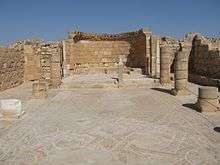Mampsis
Mampsis (Medieval Greek:Μαμψις) is the Nabataean city of Mamshit (Hebrew: ממשית) or Memphis (Ancient Greek: Μέμφις). In the Nabataean period, Mampsis was an important station on Incense Road, running from the Idumean Mountains, through the Arabah and Ma'ale Akrabim, and on to Beer-Sheva or to Hebron and Jerusalem. The city covers 10 acres (40,000 m2) and is the smallest but best restored city in the Negev Desert. The once-luxurious houses feature unusual architecture not found in any other Nabataean city.
ממשית | |
 The Mampsis Church | |
 Shown within Israel | |
| Alternative name | Mamshit Memphis |
|---|---|
| Location | Southern District, Israel |
| Region | Negev |
| Coordinates | 31.025°N 35.064°E |
| Type | Settlement |
| History | |
| Founded | 1st century BC |
| Cultures | Nabataean, Roman, Byzantine |
| Site notes | |
| Condition | In ruins |
| Official name | Incense Route - Desert Cities in the Negev (Haluza, Mamshit, Avdat and Shivta) |
| Type | Cultural |
| Criteria | iii, v |
| Designated | 2005 (29th session) |
| Reference no. | 1107 |
| State Party | Israel |
| Region | Europe and North America |
The reconstructed city gives the visitor a sense of how Mampsis once looked. Entire streets have survived intact, and there are also large groups of Nabataean buildings with open rooms, courtyards, and terraces. The stones are carefully chiseled and the arches that support the ceiling are remarkably well constructed.
Name
The Medieval Greek name Mampsis (Μαμψις) appears on the Madaba map and in the writings of Church Fathers.[1] The Negev Naming Committee chose to Hebraize the name as Mamshit (ממשית), with one committee member stating that it is "impossible to leave the name Mampsis because it's a foreign name"; the committee concluded that Mamshit was the original Hebrew name, which had been distorted by the Greeks.[1]
History
.jpg)
Mampsis was founded in the 1st century BC as trade post between Petra and Gaza. Also based on agriculture, it continued to develop over time. When its trade with the Roman occupation waned the city developed a lucrative trade breeding fine horses, notably, the renowned Arabian horse. During the Byzantine period Mampsis received support from the authorities as a frontier city until the time of Justinian when this funding ceased and the city went into decline.
Before the founding of the State of Israel, Prime Minister to-be David Ben-Gurion saw Mampsis as the capital of the future country, which dovetailed with his dream of settling the Negev Desert.
Two churches were discovered in Mampsis. The western St. Nilus Church has a mosaic floor with colourful geometric patterns, birds, a fruit basket, and five dedications in Greek. The eastern church has a lectern on small marble pillars, the remnants of which can be seen at the site.
The biggest hoard of treasure ever found in Israel was discovered in Mampsis; 10,500 silver coins, a 72Kg, lead ingot with its foundry markings, a collection of ancient Greek texts on papyrus, and other objects indicative of wealthy people.
Mampsis was declared a world heritage site by UNESCO in June 2005.
Gallery
 Mosaic floor of the Church of St. Nilus, Mampsis
Mosaic floor of the Church of St. Nilus, Mampsis The Guardhouse (left) and Wealthy House (right).
The Guardhouse (left) and Wealthy House (right).

References
- Benvenisti, Meron (1 March 2000). "The Hebrew Map". Sacred Landscape: The Buried History of the Holy Land since 1948. University of California Press. p. 22. ISBN 978-0-520-92882-4.
External links
- Mamshit National Park - official site
- Incense Route - Desert Cities in the Negev, UNESCO
- Pictures of Mamshit archeological findings
- Mamshit Detailed track and hiking info from Tourism, trip and travel to Israel
| Wikimedia Commons has media related to Mamshit. |